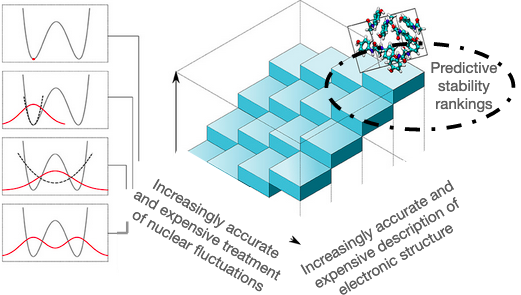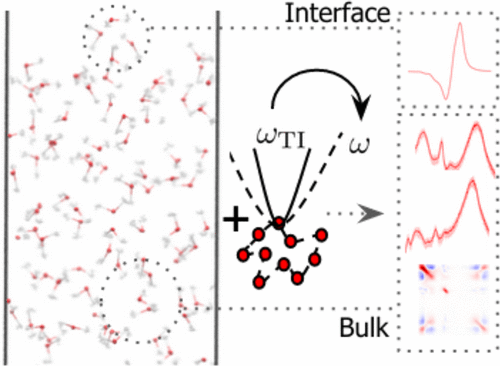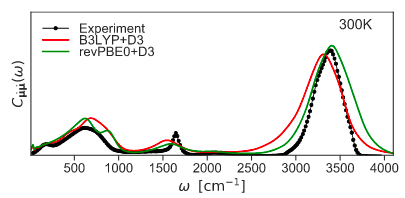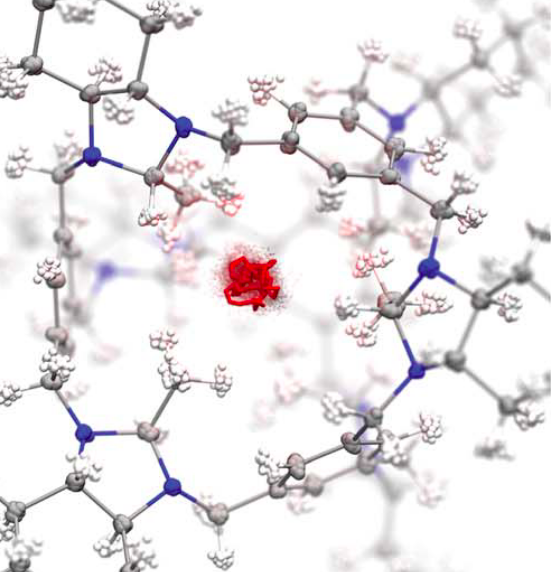Quantum nuclear motion
We develop efficient approaches, combining quantum-mechanics and machine learning, to incorporate explicit quantum nuclear motion in atomistic simulations.
Selected Publications
-
 Quantum dynamics using path integral coarse-grainingFélix Musil, Iryna Zaporozhets, Frank Noé, and 2 more authorsAug 2022
Quantum dynamics using path integral coarse-grainingFélix Musil, Iryna Zaporozhets, Frank Noé, and 2 more authorsAug 2022Vibrational spectra of condensed and gas-phase systems containing light nuclei are influenced by their quantum-mechanical behaviour. The quantum dynamics of light nuclei can be approximated by the imaginary time path integral (PI) formulation, but still at a large computational cost that increases sharply with decreasing temperature. By leveraging advances in machine-learned coarse-graining, we develop a PI method with the reduced computational cost of a classical simulation. We also propose a simple temperature elevation scheme to significantly attenuate the artefacts of standard PI approaches and also eliminates the unfavourable temperature scaling of the computational cost.We illustrate the approach, by calculating vibrational spectra using standard models of water molecules and bulk water, demonstrating significant computational savings and dramatically improved accuracy compared to more expensive reference approaches. We believe that our simple, efficient and accurate method could enable routine calculations of vibrational spectra including nuclear quantum effects for a wide range of molecular systems.
@misc{musil_quantum_2022, title = {Quantum dynamics using path integral coarse-graining}, doi = {10.48550/arXiv.2208.06205}, urldate = {2022-08-19}, publisher = {arXiv}, author = {Musil, Félix and Zaporozhets, Iryna and Noé, Frank and Clementi, Cecilia and Kapil, Venkat}, month = aug, year = {2022}, note = {arXiv:2208.06205 [cond-mat, physics:physics, physics:quant-ph]}, keywords = {Condensed Matter - Materials Science, Condensed Matter - Soft Condensed Matter, Condensed Matter - Statistical Mechanics, Physics - Chemical Physics, Quantum Physics}, pi = {true}, mlps = {true} } -
 i-PI 2.0: A universal force engine for advanced molecular simulationsVenkat Kapil, Mariana Rossi, Ondrej Marsalek, and 24 more authorsComputer Physics Communications Mar 2019
i-PI 2.0: A universal force engine for advanced molecular simulationsVenkat Kapil, Mariana Rossi, Ondrej Marsalek, and 24 more authorsComputer Physics Communications Mar 2019Progress in the atomic-scale modeling of matter over the past decade has been tremendous. This progress has been brought about by improvements in methods for evaluating interatomic forces that work by either solving the electronic structure problem explicitly, or by computing accurate approximations of the solution and by the development of techniques that use the Born–Oppenheimer (BO) forces to move the atoms on the BO potential energy surface. As a consequence of these developments it is now possible to identify stable or metastable states, to sample configurations consistent with the appropriate thermodynamic ensemble, and to estimate the kinetics of reactions and phase transitions. All too often, however, progress is slowed down by the bottleneck associated with implementing new optimization algorithms and/or sampling techniques into the many existing electronic-structure and empirical-potential codes. To address this problem, we are thus releasing a new version of the i-PI software. This piece of software is an easily extensible framework for implementing advanced atomistic simulation techniques using interatomic potentials and forces calculated by an external driver code. While the original version of the code (Ceriotti et al., 2014) was developed with a focus on path integral molecular dynamics techniques, this second release of i-PI not only includes several new advanced path integral methods, but also offers other classes of algorithms. In other words, i-PI is moving towards becoming a universal force engine that is both modular and tightly coupled to the driver codes that evaluate the potential energy surface and its derivatives. Program summary Program Title: i-PI Program Files doi: http://dx.doi.org/10.17632/x792grbm9g.1 Licensing provisions: GPLv3, MIT Programming language: Python External routines/libraries: NumPy Nature of problem: Lowering the implementation barrier to bring state-of-the-art sampling and atomistic modeling techniques to ab initio and empirical potentials programs. Solution method: Advanced sampling methods, including path-integral molecular dynamics techniques, are implemented in a Python interface. Any electronic structure code can be patched to receive the atomic coordinates from the Python interface, and to return the forces and energy that are used to integrate the equations of motion, optimize atomic geometries, etc. Restrictions: This code does not compute interatomic potentials, although the distribution includes sample driver codes that can be used to test different techniques using a few simple model force fields.
@article{kapil_i-pi_2019, title = {i-{PI} 2.0: {A} universal force engine for advanced molecular simulations}, volume = {236}, issn = {0010-4655}, shorttitle = {i-{PI} 2.0}, url = {http://www.sciencedirect.com/science/article/pii/S0010465518303436}, doi = {10.1016/j.cpc.2018.09.020}, language = {en}, urldate = {2019-12-04}, journal = {Computer Physics Communications}, author = {Kapil, Venkat and Rossi, Mariana and Marsalek, Ondrej and Petraglia, Riccardo and Litman, Yair and Spura, Thomas and Cheng, Bingqing and Cuzzocrea, Alice and Meißner, Robert H. and Wilkins, David M. and Helfrecht, Benjamin A. and Juda, Przemysław and Bienvenue, Sébastien P. and Fang, Wei and Kessler, Jan and Poltavsky, Igor and Vandenbrande, Steven and Wieme, Jelle and Corminboeuf, Clemence and Kühne, Thomas D. and Manolopoulos, David E. and Markland, Thomas E. and Richardson, Jeremy O. and Tkatchenko, Alexandre and Tribello, Gareth A. and Van Speybroeck, Veronique and Ceriotti, Michele}, month = mar, year = {2019}, keywords = {Accelerated sampling, Geometry optimizers, Molecular dynamics, Path integral}, pages = {214--223}, pi = {true} } -
 A complete description of thermodynamic stabilities of molecular crystalsVenkat Kapil, and Edgar A. EngelProceedings of the National Academy of Sciences Feb 2022
A complete description of thermodynamic stabilities of molecular crystalsVenkat Kapil, and Edgar A. EngelProceedings of the National Academy of Sciences Feb 2022Predictions of relative stabilities of (competing) molecular crystals are of great technological relevance, most notably for the pharmaceutical industry. However, they present a long-standing challenge for modeling, as often minuscule free energy differences are sensitively affected by the description of electronic structure, the statistical mechanics of the nuclei and the cell, and thermal expansion. The importance of these effects has been individually established, but rigorous free energy calculations for general molecular compounds, which simultaneously account for all effects, have hitherto not been computationally viable. Here we present an efficient “end to end” framework that seamlessly combines state-of-the art electronic structure calculations, machine-learning potentials, and advanced free energy methods to calculate ab initio Gibbs free energies for general organic molecular materials. The facile generation of machine-learning potentials for a diverse set of polymorphic compounds—benzene, glycine, and succinic acid—and predictions of thermodynamic stabilities in qualitative and quantitative agreement with experiments highlight that predictive thermodynamic studies of industrially relevant molecular materials are no longer a daunting task.
@article{kapil_complete_2022, title = {A complete description of thermodynamic stabilities of molecular crystals}, volume = {119}, copyright = {Copyright © 2022 the Author(s). Published by PNAS.. https://creativecommons.org/licenses/by/4.0/This open access article is distributed under Creative Commons Attribution License 4.0 (CC BY).}, issn = {0027-8424, 1091-6490}, url = {https://www.pnas.org/content/119/6/e2111769119}, doi = {10.1073/pnas.2111769119}, language = {en}, number = {6}, urldate = {2022-02-10}, journal = {Proceedings of the National Academy of Sciences}, author = {Kapil, Venkat and Engel, Edgar A.}, month = feb, year = {2022}, pmid = {35131847}, keywords = {Condensed Matter - Materials Science, Condensed Matter - Statistical Mechanics, ab initio thermodynamics, machine learning, polymorphism, statistical mechanics}, pi = {true}, mlps = {true}, csp = {true} } -
 Efficient Quantum Vibrational Spectroscopy of Water with High-Order Path Integrals: From Bulk to InterfacesSam Shepherd, Jinggang Lan, David M. Wilkins, and 1 more authorThe Journal of Physical Chemistry Letters Sep 2021
Efficient Quantum Vibrational Spectroscopy of Water with High-Order Path Integrals: From Bulk to InterfacesSam Shepherd, Jinggang Lan, David M. Wilkins, and 1 more authorThe Journal of Physical Chemistry Letters Sep 2021Vibrational spectroscopy is key in probing the interplay between the structure and dynamics of aqueous systems. To map different regions of experimental spectra to the microscopic structure of a system, it is important to combine them with first-principles atomistic simulations that incorporate the quantum nature of nuclei. Here we show that the large cost of calculating the quantum vibrational spectra of aqueous systems can be dramatically reduced compared with standard path integral methods by using approximate quantum dynamics based on high-order path integrals. Together with state-of-the-art machine-learned electronic properties, our approach gives an excellent description not only of the infrared and Raman spectra of bulk water but also of the 2D correlation and the more challenging sum-frequency generation spectra of the water–air interface. This paves the way for understanding complex interfaces such as water encapsulated between or in contact with hydrophobic and hydrophilic materials through robust and inexpensive surface-sensitive and multidimensional spectra with first-principles accuracy.
@article{shepherd_efficient_2021, title = {Efficient {Quantum} {Vibrational} {Spectroscopy} of {Water} with {High}-{Order} {Path} {Integrals}: {From} {Bulk} to {Interfaces}}, shorttitle = {Efficient {Quantum} {Vibrational} {Spectroscopy} of {Water} with {High}-{Order} {Path} {Integrals}}, url = {https://doi.org/10.1021/acs.jpclett.1c02574}, doi = {10.1021/acs.jpclett.1c02574}, urldate = {2021-09-21}, journal = {The Journal of Physical Chemistry Letters}, author = {Shepherd, Sam and Lan, Jinggang and Wilkins, David M. and Kapil, Venkat}, month = sep, year = {2021}, pages = {9108--9114}, pi = {true} } -
 Simulating the ghost: quantum dynamics of the solvated electronJinggang Lan, Venkat Kapil, Piero Gasparotto, and 3 more authorsNature Communications Feb 2021
Simulating the ghost: quantum dynamics of the solvated electronJinggang Lan, Venkat Kapil, Piero Gasparotto, and 3 more authorsNature Communications Feb 2021The nature of the bulk hydrated electron has been a challenge for both experiment and theory due to its short lifetime and high reactivity, and the need for a high-level of electronic structure theory to achieve predictive accuracy. The lack of a classical atomistic structural formula makes it exceedingly difficult to model the solvated electron using conventional empirical force fields, which describe the system in terms of interactions between point particles associated with atomic nuclei. Here we overcome this problem using a machine-learning model, that is sufficiently flexible to describe the effect of the excess electron on the structure of the surrounding water, without including the electron in the model explicitly. The resulting potential is not only able to reproduce the stable cavity structure but also recovers the correct localization dynamics that follow the injection of an electron in neat water. The machine learning model achieves the accuracy of the state-of-the-art correlated wave function method it is trained on. It is sufficiently inexpensive to afford a full quantum statistical and dynamical description and allows us to achieve accurate determination of the structure, diffusion mechanisms, and vibrational spectroscopy of the solvated electron.
@article{lan_simulating_2021, title = {Simulating the ghost: quantum dynamics of the solvated electron}, volume = {12}, copyright = {2021 The Author(s)}, issn = {2041-1723}, shorttitle = {Simulating the ghost}, url = {https://www.nature.com/articles/s41467-021-20914-0}, doi = {10.1038/s41467-021-20914-0}, language = {en}, number = {1}, urldate = {2021-07-29}, journal = {Nature Communications}, author = {Lan, Jinggang and Kapil, Venkat and Gasparotto, Piero and Ceriotti, Michele and Iannuzzi, Marcella and Rybkin, Vladimir V.}, month = feb, year = {2021}, pages = {766}, pi = {true} } -
 Inexpensive modeling of quantum dynamics using path integral generalized Langevin equation thermostatsVenkat Kapil, David M. Wilkins, Jinggang Lan, and 1 more authorThe Journal of Chemical Physics Mar 2020
Inexpensive modeling of quantum dynamics using path integral generalized Langevin equation thermostatsVenkat Kapil, David M. Wilkins, Jinggang Lan, and 1 more authorThe Journal of Chemical Physics Mar 2020The properties of molecules and materials containing light nuclei are affected by their quantum mechanical nature. Accurate modeling of these quantum nuclear effects requires computationally demanding path integral techniques. Considerable success has been achieved in reducing the cost of such simulations by using generalized Langevin dynamics to induce frequency-dependent fluctuations. Path integral generalized Langevin equation methods, however, have this far been limited to the study of static, thermodynamic properties due to the large perturbation to the system’s dynamics induced by the aggressive thermostatting. Here, we introduce a post-processing scheme, based on analytical estimates of the dynamical perturbation induced by the generalized Langevin dynamics, which makes it possible to recover meaningful time correlation properties from a thermostatted trajectory. We show that this approach yields spectroscopic observables for model and realistic systems that have an accuracy comparable to much more demanding approximate quantum dynamics techniques based on full path integral simulations.
@article{kapil_inexpensive_2020, title = {Inexpensive modeling of quantum dynamics using path integral generalized {Langevin} equation thermostats}, volume = {152}, issn = {0021-9606}, url = {https://aip.scitation.org/doi/10.1063/1.5141950}, doi = {10.1063/1.5141950}, number = {12}, urldate = {2020-10-28}, journal = {The Journal of Chemical Physics}, author = {Kapil, Venkat and Wilkins, David M. and Lan, Jinggang and Ceriotti, Michele}, month = mar, year = {2020}, pages = {124104}, pi = {true} } -
 Barely porous organic cages for hydrogen isotope separationMing Liu, Linda Zhang, Marc A. Little, and 13 more authorsScience Nov 2019
Barely porous organic cages for hydrogen isotope separationMing Liu, Linda Zhang, Marc A. Little, and 13 more authorsScience Nov 2019Quantum sieves for hydrogen isotopes One method for improving the efficiency of separation of hydrogen from deuterium (D) is to exploit kinetic quantum sieving with nanoporous solids. This method requires ultrafine pore apertures (around 3 angstroms), which usually leads to low pore volumes and low D2 adsorption capacities. Liu et al. used organic synthesis to tune the pore size of the internal cavities of organic cage molecules. A hybrid cocrystal contained both a small-pore cage that imparted high selectivity and a larger-pore cage that enabled high D2 uptake. Science, this issue p. 613 The separation of hydrogen isotopes for applications such as nuclear fusion is a major challenge. Current technologies are energy intensive and inefficient. Nanoporous materials have the potential to separate hydrogen isotopes by kinetic quantum sieving, but high separation selectivity tends to correlate with low adsorption capacity, which can prohibit process scale-up. In this study, we use organic synthesis to modify the internal cavities of cage molecules to produce hybrid materials that are excellent quantum sieves. By combining small-pore and large-pore cages together in a single solid, we produce a material with optimal separation performance that combines an excellent deuterium/hydrogen selectivity (8.0) with a high deuterium uptake (4.7 millimoles per gram). Cocrystals of modified molecular organic crystals can separate hydrogen from deuterium through kinetic quantum sieving. Cocrystals of modified molecular organic crystals can separate hydrogen from deuterium through kinetic quantum sieving.
@article{liu_barely_2019, title = {Barely porous organic cages for hydrogen isotope separation}, volume = {366}, copyright = {Copyright © 2019 The Authors, some rights reserved; exclusive licensee American Association for the Advancement of Science. No claim to original U.S. Government Works. http://www.sciencemag.org/about/science-licenses-journal-article-reuseThis is an article distributed under the terms of the Science Journals Default License.}, issn = {0036-8075, 1095-9203}, url = {https://science.sciencemag.org/content/366/6465/613}, doi = {10.1126/science.aax7427}, language = {en}, number = {6465}, urldate = {2019-11-18}, journal = {Science}, author = {Liu, Ming and Zhang, Linda and Little, Marc A. and Kapil, Venkat and Ceriotti, Michele and Yang, Siyuan and Ding, Lifeng and Holden, Daniel L. and Balderas-Xicohténcatl, Rafael and He, Donglin and Clowes, Rob and Chong, Samantha Y. and Schütz, Gisela and Chen, Linjiang and Hirscher, Michael and Cooper, Andrew I.}, month = nov, year = {2019}, pmid = {31672893}, pages = {613--620}, pi = {true} }